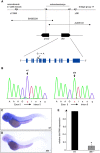Loss of dihydrolipoyl succinyltransferase (DLST) leads to reduced resting heart rate in the zebrafish
- PMID: 25697682
- PMCID: PMC4335124
- DOI: 10.1007/s00395-015-0468-7
Loss of dihydrolipoyl succinyltransferase (DLST) leads to reduced resting heart rate in the zebrafish
Abstract
The genetic underpinnings of heart rate regulation are only poorly understood. In search for genetic regulators of cardiac pacemaker activity, we isolated in a large-scale mutagenesis screen the embryonic lethal, recessive zebrafish mutant schneckentempo (ste). Homozygous ste mutants exhibit a severely reduced resting heart rate with normal atrio-ventricular conduction and contractile function. External electrical pacing reveals that defective excitation generation in cardiac pacemaker cells underlies bradycardia in ste (-/-) mutants. By positional cloning and gene knock-down analysis we find that loss of dihydrolipoyl succinyltransferase (DLST) function causes the ste phenotype. The mitochondrial enzyme DLST is an essential player in the citric acid cycle that warrants proper adenosine-tri-phosphate (ATP) production. Accordingly, ATP levels are significantly diminished in ste (-/-) mutant embryos, suggesting that limited energy supply accounts for reduced cardiac pacemaker activity in ste (-/-) mutants. We demonstrate here for the first time that the mitochondrial enzyme DLST plays an essential role in the modulation of the vertebrate heart rate by controlling ATP production in the heart.
Figures






Similar articles
-
Metabolic Enzyme DLST Promotes Tumor Aggression and Reveals a Vulnerability to OXPHOS Inhibition in High-Risk Neuroblastoma.Cancer Res. 2021 Sep 1;81(17):4417-4430. doi: 10.1158/0008-5472.CAN-20-2153. Epub 2021 Jul 7. Cancer Res. 2021. PMID: 34233924 Free PMC article.
-
Modulation by DLST of the genetic risk of Alzheimer's disease in a very elderly population.Ann Neurol. 1999 Jan;45(1):48-53. Ann Neurol. 1999. PMID: 9894876
-
A transgenic zebrafish model of a human cardiac sodium channel mutation exhibits bradycardia, conduction-system abnormalities and early death.J Mol Cell Cardiol. 2013 Aug;61:123-32. doi: 10.1016/j.yjmcc.2013.06.005. Epub 2013 Jun 19. J Mol Cell Cardiol. 2013. PMID: 23791817
-
A novel protein found in the I bands of myofibrils is produced by alternative splicing of the DLST gene.Biochim Biophys Acta. 2010 Jan;1800(1):31-9. doi: 10.1016/j.bbagen.2009.10.003. Epub 2009 Oct 9. Biochim Biophys Acta. 2010. PMID: 19819302
-
The TCA cycle transferase DLST is important for MYC-mediated leukemogenesis.Leukemia. 2016 Jun;30(6):1365-74. doi: 10.1038/leu.2016.26. Epub 2016 Feb 15. Leukemia. 2016. PMID: 26876595 Free PMC article.
Cited by
-
Identification of Hub Genes in Protective Effect of Astragaloside IV on Aconitine-Induced Cardiac Damage in Zebrafish Based on Bioinformatics Analysis.Front Pharmacol. 2020 Jun 24;11:957. doi: 10.3389/fphar.2020.00957. eCollection 2020. Front Pharmacol. 2020. PMID: 32670070 Free PMC article.
-
Association of OGG1 and DLST promoter methylation with Alzheimer's disease in Xinjiang population.Exp Ther Med. 2018 Oct;16(4):3135-3142. doi: 10.3892/etm.2018.6524. Epub 2018 Jul 26. Exp Ther Med. 2018. PMID: 30214536 Free PMC article.
-
Loss of the novel Vcp (valosin containing protein) interactor Washc4 interferes with autophagy-mediated proteostasis in striated muscle and leads to myopathy in vivo.Autophagy. 2018;14(11):1911-1927. doi: 10.1080/15548627.2018.1491491. Epub 2018 Aug 16. Autophagy. 2018. PMID: 30010465 Free PMC article.
-
Proteomic analysis revealed the pharmacological mechanism of Xueshuantong injection in preventing early acute myocardial infarction injury.Front Pharmacol. 2022 Dec 21;13:1010079. doi: 10.3389/fphar.2022.1010079. eCollection 2022. Front Pharmacol. 2022. PMID: 36618918 Free PMC article.
-
Zebrafish as model system for the biological characterization of CK1 inhibitors.Front Pharmacol. 2023 Sep 11;14:1245246. doi: 10.3389/fphar.2023.1245246. eCollection 2023. Front Pharmacol. 2023. PMID: 37753113 Free PMC article.
References
Publication types
MeSH terms
Substances
LinkOut - more resources
Full Text Sources
Other Literature Sources
Molecular Biology Databases
Research Materials

